
Audubon Adventures

Background for Teachers
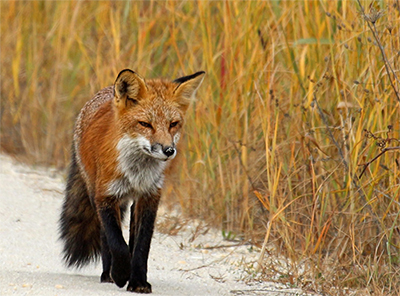
It’s a jungle out there! Most people just don’t realize how many species of animals live in urban and suburban settings. Our city neighbors include assorted birds, mammals, reptiles, amphibians, fish, and insects, spiders, and countless other invertebrates, sometimes in greater numbers than they would be found in the wild. In metropolitan parks, vacant lots, lawns, fields, street trees, cemeteries, landfills, and waste areas, wildlife communities coexist with the built environment. Some species even set up housekeeping on or in the buildings themselves.
Wildlife Adapts to Sharing Space
How did these critters become city slickers? As urbanization of rural lands forced out many wild species, versatile animals flourished in the built environment because of reduced competition and predation. Cities also offer sources of food and places to den. For animals with the entrepreneurial spirit, opportunity abounds in the city. A number of animals were able to adapt to this new environment.
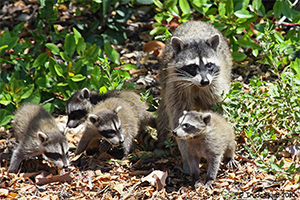 The raccoon is one species that has thrived (and sometimes become a nuisance) in the city. Raccoon numbers are often far greater in urban environments than in rural ones. In cities, occupied and vacant buildings, garages, and churches replace hollow trees as denning sites. Where natural food sources are scarce, raccoons dine on garbage or raid gardens and bird feeders. For intra-city travel safe from traffic and dogs, raccoons often use storm sewers, surfacing periodically at street corners to inspect the contents of waste receptacles. They earn their living by canvassing the city at night.
The raccoon is one species that has thrived (and sometimes become a nuisance) in the city. Raccoon numbers are often far greater in urban environments than in rural ones. In cities, occupied and vacant buildings, garages, and churches replace hollow trees as denning sites. Where natural food sources are scarce, raccoons dine on garbage or raid gardens and bird feeders. For intra-city travel safe from traffic and dogs, raccoons often use storm sewers, surfacing periodically at street corners to inspect the contents of waste receptacles. They earn their living by canvassing the city at night.
Squirrels—including gray, red, and fox squirrels—and in some instances chipmunks are another urban success story. They flourish in parts of the city that have mature street trees. Parks and cemeteries are also havens for squirrels.
Read more.
Urban Predators and Browsers
Coyotes have found that there are abundant food sources associated with humans. Garbage, food litter, and pet food lure these critters into urban environments. A close relative, the red fox, often dens in wooded areas within the limits of large towns and cities, supplementing its diet of natural prey with garbage.
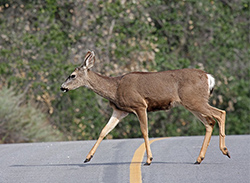 Sometimes deer exist within city limits and suburban areas in densities greater than in the wild. In these cases, they are finding good winter cover and plenty of browse from trees and shrubs. In some urban areas, herds can move in and out through a river drainage or other greenbelt. In most places, however, fences, roads, and other obstacles tend to confine deer to specific areas. They can do so well in metropolitan areas that conflicts arise.
Sometimes deer exist within city limits and suburban areas in densities greater than in the wild. In these cases, they are finding good winter cover and plenty of browse from trees and shrubs. In some urban areas, herds can move in and out through a river drainage or other greenbelt. In most places, however, fences, roads, and other obstacles tend to confine deer to specific areas. They can do so well in metropolitan areas that conflicts arise.
A Falcon Moves to the City
One of the most surprising animals to adapt to urban environments is the spectacular peregrine falcon, which prefers to nest on inaccessible ledges and cliffs. In the early part of the 20th century, a few peregrines were found in Eastern cities, where they found the cliff-like window ledges of tall buildings serviceable for nesting and roosting. Widespread use of DDT and related pesticides decimated peregrine populations nationwide in the 1960s and this raptor was classified as endangered. Conservation efforts were successful, however, and the peregrine falcon was delisted in 1999. Falcons are now doing well in a number of cities across the country, from New York to Chicago to San Francisco, where they roost and nest on bridges and buildings and prey on a seemingly unlimited supply of pigeons. Peregrines also eat a variety of other birds, including species such as woodpeckers and various shorebirds that pass through cities on their annual migrations.
Introduced Species, Mixed Results
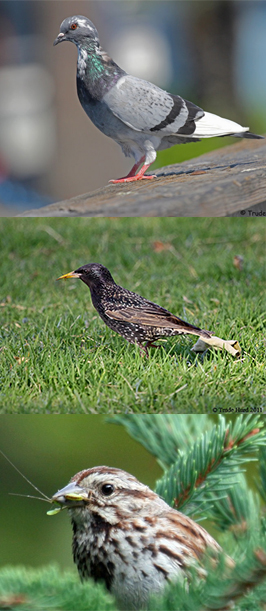 Other animals that thrive in cities were introduced, either intentionally or inadvertently, by a variety of methods. Some came on ships along with the first Europeans to settle in North America. The ubiquitous house mouse and Norway rat arrived on American shores from Europe in this way. Various species of cockroach were also accidentally introduced from Europe, Africa, and Asia. On the other hand, the valuable European honey bee and the domesticated rock dove, or pigeon, were brought along for honey and food by the immigrant pioneers. As this nation industrialized, cities provided new opportunities for both people and creatures, and the influx to the urban centers was on. Rats, mice, cockroaches, pigeons, and other introduced animals found plentiful sources of food and shelter in the urban environment.
Other animals that thrive in cities were introduced, either intentionally or inadvertently, by a variety of methods. Some came on ships along with the first Europeans to settle in North America. The ubiquitous house mouse and Norway rat arrived on American shores from Europe in this way. Various species of cockroach were also accidentally introduced from Europe, Africa, and Asia. On the other hand, the valuable European honey bee and the domesticated rock dove, or pigeon, were brought along for honey and food by the immigrant pioneers. As this nation industrialized, cities provided new opportunities for both people and creatures, and the influx to the urban centers was on. Rats, mice, cockroaches, pigeons, and other introduced animals found plentiful sources of food and shelter in the urban environment.
European starlings were introduced to New York City’s Central Park in 1880 by a wealthy druggist who was attempting to establish all of the species of birds mentioned in the works of William Shakespeare. His nightingales and skylarks never adapted to their new surroundings, but the starlings apparently had the right entrepreneurial stuff. Built environments provided such good springtime nesting opportunities for the cavity-nesting starling—and farmlands provided such a good source of grain in autumn and winter—that its ranks now reach from coast to coast and its numbers are legion. And all from 120 birds released in Central Park.
The highly urban house sparrow (formerly called the English sparrow) also passed the Statue of Liberty in New York Harbor on its way to a new life in the United States. It was originally brought to New York City from England in the 1850s by immigrants eager to bring a bit of “home” with them to the New World. Now it is found in vast numbers in cities all over the country.
In much the same fashion, American ports are still entryways for exotic species. An animal (or plant) accidentally introduced can enjoy a population boom and expand its range. The zebra mussel is an example of an introduced species that is doing so well in U.S. rivers and lakes that it is creating serious problems. They attach to hard surfaces such as pipes, motors, rocks, and even native mussels, clogging water lines and disrupting the food chain.
Open Spaces Attract Critters
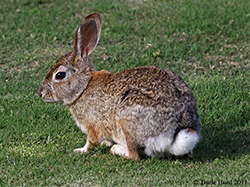 Where large areas of open space exist within city limits, there is the opportunity to find other types of wildlife. City parks, cemeteries, and other open areas provide habitat for muskrats, opossums, skunks, minks, weasels, woodchucks, rabbits, pheasants, quail, crows, hawks, owls, moles, shrews, bats, and field mice. In the spring, these places are often birding “hot spots,” where migrating birds stop to rest and feed before moving on.
Where large areas of open space exist within city limits, there is the opportunity to find other types of wildlife. City parks, cemeteries, and other open areas provide habitat for muskrats, opossums, skunks, minks, weasels, woodchucks, rabbits, pheasants, quail, crows, hawks, owls, moles, shrews, bats, and field mice. In the spring, these places are often birding “hot spots,” where migrating birds stop to rest and feed before moving on.
Waterfowl take advantage of urban water supply areas and recreational lakes. Reptiles, amphibians, and fish may also be found in urban environments, although the effects of urbanization generally wreak havoc with these sensitive cold-blooded animals. The more hardy species of toads, turtles, snakes, and lizards can often be seen in city parks, neighborhoods, and open lots.
Making Do
Cities are certainly limiting places for wildlife. Many species are driven away as nesting, shelter, and feeding sites are developed, paved, drained, mowed, or filled. Urban areas do not offer a lot of variety—the buildings, roadways, and vegetation are all pretty much the same. But for the adaptable, opportunistic critters that can make a go of it, cities can offer all they need to survive. Cities are also temporary homes to millions of birds that take advantage of street trees, small parks, campuses, and all sorts of tiny patches of greenery as places to stop and rest during migration. Large numbers of these birds collide with buildings during migration, resulting in injury and death.
Photos: (Fox, sparrow) Kelly Hunt; (all others) Trude Hurd.




